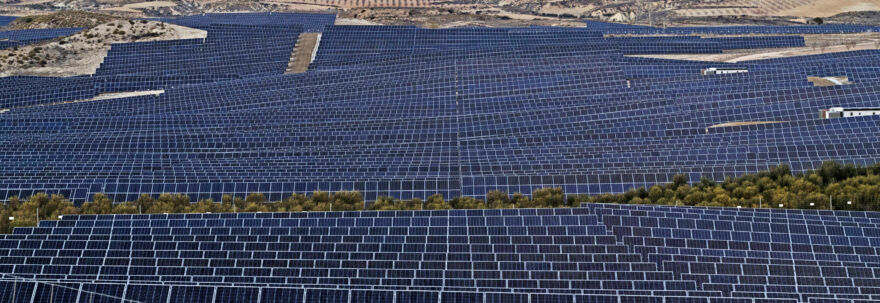At a time when the transition to renewable energy sources is becoming more and more urgent, there are more and more debates about mega solar power plants and their environmental impact. While a new study supports the idea that these facilities respect biodiversity, the number of protests and allegations against these large-scale projects is growing. This article addresses the debate between the installation of photovoltaic plants as a necessary measure to promote renewable energy and the need to preserve biodiversity, soil and landscape.
A recent report by the University of Castilla-La Mancha (UCLM), the E.T.S.I. Agrónomos y de Montes de Albacete and the Renewable Energy Research Institute, entitled “Report on environmental impacts associated with the construction of solar plants in La Mancha”, seeks to provide a diagnosis of the positive environmental effects of photovoltaic solar plants on ecosystems farmers in the area. According to the study, plant diversity in a photovoltaic installation is significantly higher than in traditional drying agrosystems, and similar to that of agricultural crops without soil treatments that allow the development of spontaneous vegetation. In addition, it is highlighted that the vegetation recovers after the construction of a solar plant adopting the floristic composition of the surroundings, which results in a richer and more diverse transitional ecosystem in the interior limits of the solar park. This supports the idea that mega solar power plants do not have a significant negative impact on biodiversity.
However, despite the arguments in favor of solar plants, numerous protests and allegations have arisen against these megaparks in different parts of Spain. Specifically, the region of Castilla-La Mancha has witnessed criticism from the “Salvemos los Campos” platform. Who denounces massive speculation and the alleged damage to biodiversity. This collective citizen, backed by 17 other associations and entities under the umbrella of Alianza Energía y Territorio (ALIENTE), has requested a moratorium on the installation of photovoltaic plants until there is a global regulatory framework in Spain. Allegations have also been filed against specific projects, such as the case of the ‘ISF Ebisu’ and ‘Ebisu II’ macro photovoltaic plants in the Toledo municipalities of La Torre de Esteban Hambrán, Casarrubios del Monte and Méntrida.
An important aspect of the protests is concern about the environmental and economic impact that mega solar power plants can have on local communities. Demonstrations in Almería, memory of around a thousand people who defend a truly sustainable energy model. According to the protesters, these large-scale plants occupy a large area of land, causing a transformation of the landscape and a significant loss of biodiversity. They highlight a negative socioeconomic impact, since the construction of mega photovoltaic plants can displace agricultural activity and affect the local communities that depend on it.
In addition, they raise the concern that the energy generated by these mega plants does not remain in the region, not even in Spain, but is exported to other European countries. This raises questions about the real benefits that these facilities bring to local communities in terms of electricity prices and long-term employment. Some organizations point out that while mega-plants can generate employment in the short-term during installation, in the long term only staff are required for surveillance and maintenance. In addition, there are fears that the installation of these plants on a large scale will degrade the environment and the local economy, negatively affecting sectors such as sustainable tourism and agriculture.
The debate about mega solar power plants and their environmental impact continues to generate contrary opinions. While some studies support the idea that these facilities do not have a significant negative impact on biodiversity and can promote vegetation recovery, there are legitimate arguments about landscape transformation, biodiversity loss, and socioeconomic impacts. In addition, the lack of a clear and transparent regulatory framework generates uncertainty and discontent among the population.
It is important to consider the benefits and possible negative impacts on biodiversity, the landscape and local communities. The search for sustainable solutions and the participation of all interested parties is key to finding a balance between solar energy production and environmental protection. In addition, a comprehensive regulatory framework is required that takes into account the environmental, social and economic aspects of solar mega-plants.
The transition to renewable energy sources is essential in the fight against climate change, but it is also important to ensure that these transitions are made in a responsible and sustainable way. This involves carefully evaluating potential impacts and seeking solutions that minimize negative effects on biodiversity, landscapes, and local communities, while encouraging clean, renewable energy generation.



